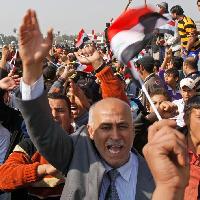
Protests in Iraqi-Kurdistan and across Sunni and Shia areas
The revolutionary volcano in the Middle East reached Iraq, this week. The largest protests took place in Iraqi Kurdistan. Around 2,000 people marched to headquarters of the ruling party, the KDP, in Sulaymaniyah. Two protesters were killed when stone-throwing youth were shot at by security forces.
The widespread discontent against poverty and unemployment in the "peaceful" Kurdish region in northern Iraq intensified after widespread electoral fraud during elections on 25 July 2009. A new movement, Gorran (‘Change’), was formed by a former deputy leader of the PUK. The new party took 25 seats and, for the first time, there is some form of opposition in the regional parliament.
The KDP and PUK have shared power in Iraqi Kurdistan since the civil war between the two parties in the mid-1990s. The KDP is led by the region’s President, Massoud Barzani, and the PUK is lead by the President of Iraq, Jalal Talabani. Both are allies of US imperialism.
Now the revolutions in Tunisia and Egypt have reached Iraq and Kurdistan. Protesters in Sulaymaniyah carried photos of Mubarak and shouted, "Down with Barzani – Game over – 20 years is enough!” Some protesters carried bread to show their anger at price increases. Most participants were young.
The local regime responded with harsh repression. Two protesters were killed and 43 were reported to have needed hospital care. In two other cities, Gorran offices were burnt down by KDP-mobs. Faced with a new demonstration in Sulaymaniyah on Friday 18 February, the KDP mobilized 3,000 armed fighters to prevent people from gathering. All traffic was stopped. Barzani attacked Thursday’s protesters as “criminals”.
There were also demonstrations in other cities in the north on Thursday, for example, the in Kurdish capital of Irbil and in Kirkuk.
Growing protests throughout Iraq
In the rest of Iraq, there are also growing protests in both Sunni and Shia-dominated areas. Around 6,000 people joined a Facebook group called ‘Iraq revolution’. In Fallujah, west Baghdad, 1,000 people marched with slogans against corruption. In Kut, in the south east, three demonstrators were killed on Wednesday during a protest against the ruling governor. Demonstrations continued in Kut on Thursday, when 1,000 people demanded that those arrested by the police should be released. Smaller demonstrations have also taken place in Basra and Nasriyah.
The revolutionary example of Egypt shows show a way forward for the masses in the region. In Iraq it provides an opportunity to overcome religious, ethnic and clan-based divisions and conflicts. The Iraqi government is afraid of mass protests. It is trying to scare people from taking to the streets by warning that the demonstrations could be exposed to terrorist bomb attacks.
But the protests show that the Kurds are far from being firm supporters of Barzani and Talabani, just as the Sunni and Shite politicians do not represent the class interests of the mass of Iraqis. A united workers’ and youth movement in Kurdistan and Iraq, in opposition to both the national, sectarian based and pro-market politicians and the imperialist occupiers, is the only way to start the process of changing society and ending conflict, poverty and joblessness. The last few days of mass protests mark the first steps towards the goal of building workers’ unity and creating mass organizations of the working masses and poor.
Special financial appeal to all readers of socialistworld.net |
Support building alternative socialist media Socialistworld.net provides a unique analysis and perspective of world events. Socialistworld.net also plays a crucial role in building the struggle for socialism across all continents. Capitalism has failed! Assist us to build the fight-back and prepare for the stormy period of class struggles ahead. Please make a donation to help us reach more readers and to widen our socialist campaigning work across the world. |
Donate via Paypal |
| M | T | W | T | F | S | S |
|---|---|---|---|---|---|---|
| 1 | 2 | 3 | 4 | 5 | 6 | |
| 7 | 8 | 9 | 10 | 11 | 12 | 13 |
| 14 | 15 | 16 | 17 | 18 | 19 | 20 |
| 21 | 22 | 23 | 24 | 25 | 26 | 27 |
| 28 | ||||||


Be the first to comment